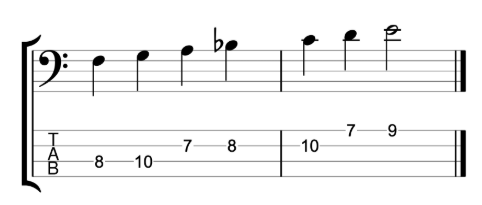The Altered Scale – Bass Practice Diary – 16th April 2019
Jazz musicians love to play on dominant 7th chords. And the altered scale is a really important scale to practice if you want to create a jazz sound when playing on these 7th chords. I think that using the altered scale is often perceived as “advanced” harmony. But, as with most things, it’s easy when you understand it. So, here’s my very quick guide to using the altered scale on bass.
What is the altered scale?
The altered scale is a mode of the melodic minor scale. Meaning that it contains all of the same intervals as a melodic minor scale. The altered scale is essentially what you get when you play a melodic minor scale starting finishing on the 7th note of the scale.
So, what’s a melodic minor scale? It’s basically only one note different from a major scale. If you take a major scale and change the major 3rd to a minor 3rd, you have a melodic minor scale.
Here’s the notes of an F major scale.

And here are the notes of an F melodic minor scale.

Notice that the only difference is the third note. It’s an A natural in the major scale and an Ab in the melodic minor.
If you play the notes of an F melodic minor scale but use E (the 7th note) as the root note. You would be playing an E altered scale.
When you think about the notes of the F melodic minor with an E as the root note, it creates these interval relationships to the root note.

The 3rd of E7 would, of course, be written as G# not Ab. But the altered scale creates some interesting theoretical anomalies like that. Because the major 3rd note (Ab/G#) is actually the 4th note of the scale.
How do you use the altered scale?
As I mentioned at the start, the altered scale works really well on dominant 7th chords. You can think of the altered scale as being a kind of extended dominant 7th arpeggio with lots of chromatic alterations.
The scale includes the root, major 3rd and dominant 7th notes which are the fundamental ingredients of a dominant 7th arpeggio. But the other four notes are all chromatic alterations of some kind. Hence why it’s called the altered scale.
You can alter chord tones and extensions by moving them one semi-tone up or down. The 5th of E7 is B natural, but in the altered scale the 5th has been flattened to Bb. So the altered scale could be used on an E7b5 chord.
The 9th can be altered by sharpening or flattening it. The altered scale uses both alterations. So you could use it on an E7b9 or an E7#9 chord. The final alteration is a b13.
So you can use the altered scale to play on any of these altered dominant chord types. And you will sometimes see the chord symbol E7alt. Which implies a chord that could include any or all of these alterations.
So if you want to start using this altered dominant sound on your dominant 7th chords. Then start to think about using a melodic minor scale that starts one semi-tone above the root of the chord. So, if you’re playing on a D7 chord, think Eb melodic minor. For A7, thing Bb melodic minor, for G7 think Ab melodic minor, for B7 think C melodic minor etc.
For another great jazz approach to playing on dominant 7th chords, check out my video guide to using diminished scale on bass.


3 thoughts on “A Quick Guide to the Altered Scale – Bass Practice Diary 52”
Comments are closed.